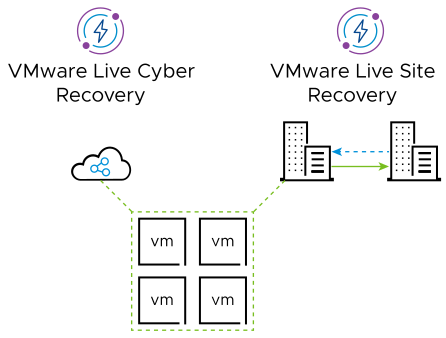You can protect the same VM using both VMware Live Site Recovery and VMware Live Cyber Recovery, but there are several considerations to be aware of.
- You can use VMware Live Site Recovery to perform failover and failback operations (disaster recovery).
- You can use VMware Live Cyber Recovery for ransomware recovery.

-
If both services are protecting the same VM, when VMware Live Site Recovery performs a planned failover of the VM from site A to site B, VMware Live Cyber Recovery protection of the VM stops. In other words, subsequent VMware Live Cyber Recovery protection group snapshots will not include this VM.
If you want to dual-protect a VM both before and after VMware Live Site Recovery failover/failback, a VMware Live Cyber Recovery site must be created for both of the VMware Live Site Recovery protected and recovery sites. You must also create VMware Live Cyber Recovery protection groups to protect both VMware Live Site Recovery sites.
- If an unplanned VMware Live Site Recovery failover is performed and is unable to demote/deactivate the production VMs and storage at the protected site, and if the protected site still has sufficient network connectivity for VMware Live Cyber Recovery snapshots to function, VMware Live Cyber Recovery will continue to protect VMs at the protected site even though they have been failed over to another site.
- If you want to protect a VM using both VMware Live Cyber Recovery and VMware Live Site Recovery, you can only protect the VM using VMware Live Site Recovery array-based replication. You cannot protect the same VM using vSphere Replication if the same VM is being protected by VMware Live Cyber Recovery high-frequency snapshots.
- Using both VMware Live Cyber Recovery and VMware Live Site Recovery can sometimes result in split-brain scenarios. For example, you perform a VMware Live Site Recovery failover of a VM from site A to site B, and you then perform VMware Live Cyber Recovery ransomware recovery of the same VM to the cloud. After these operations, two instances of the same VM will simultaneously be running, one in site A (the result of VMware Live Cyber Recovery ransomware recovery) and one in the cloud (the result of VMware Live Site Recovery ransomware recovery).
Similarly, performing a VMware Live Site Recovery failover and a VMware Live Cyber Recovery failover of the same set of VMs will result in split brain situations.
- Avoid performing a VMware Live Site Recovery failover immediately after a VMware Live Cyber Recovery failover. When VMware Live Cyber Recovery is in the process of a failover, the state of the VM will be incomplete, because only some of the data has been transferred back from the cloud to the protected site. If you attempt to perform a VMware Live Site Recovery failover while the VM's disks are in this state, the VM's disks on the protected site will appear corrupted.
As a workaround, wait until the VMware Live Cyber Recovery failover is completely finished, and then you can perform recovery operations on the VM using VMware Live Site Recovery.
- After performing a VMware Live Site Recovery failover and failback of a VM, the next VMware Live Cyber Recovery backup of the VM will require a full (not incremental) ingest of the VM’s disk data. Similarly, a VMware Live Cyber Recovery restore operation may result in significant array-based replication traffic.